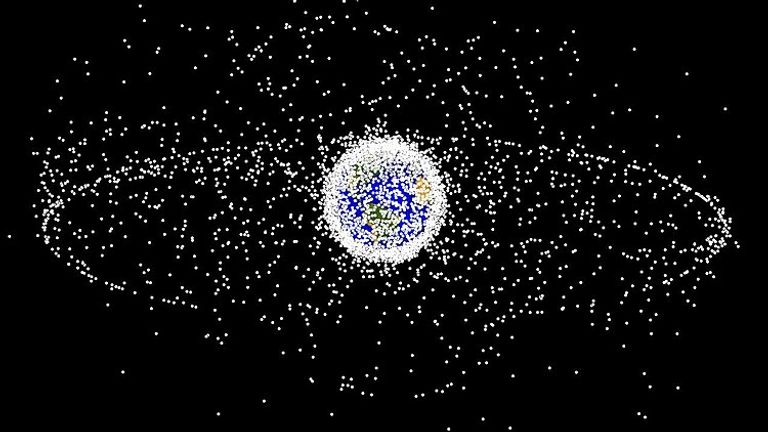Britain’s first garbage truck for space could clear up junk with a bear hug – or even the robotic equivalent of a litter-picker.
The two techniques are being proposed by companies competing for a UK contract to launch a clean-up mission as soon as 2026.
The winning prototype will track down and capture two defunct satellites, then cast them into the atmosphere where they will burn up.
There is growing alarm at the amount of debris spinning round the planet at 18,000mph. A collision with critical satellites could bring down everyday services, including telecommunications and GPS navigation.
Rory Holmes of ClearSpace, one of the competing companies, told Sky News: “For the last six decades we’ve been launching satellites into space without really thinking about what happens at the end of their life.
“When they run out of fuel or when they break, we just discard them. We leave them to clog up space.
“We’re in a situation now where space is quite congested and all these different dead objects are whizzing around, criss-crossing each other’s paths, sometimes colliding, and sometimes really getting in the way of what we want to be doing in space.”
ClearSpace is designing a spacecraft that looks a little like a giant squid, with multiple arms reaching out to wrap around a target satellite.
Complex robotics needed
Mr Holmes calls it a “bear hug”.
“We have to we have to find a way of capturing and enclosing these objects so they don’t spin away from us,” he said.
“One advantage with the mechanism we have is that we can completely get around the object before we pull it in tightly to make sure it can’t slip away and can’t go off in the direction we’re not expecting.”
The other company, Oxfordshire-based Astroscale, will use a spacecraft with a long robotic arm to grab the defunct satellite.
Jason Forshaw, head of future business at the company, said designing a spacecraft that could assess and capture an ageing satellite was a huge challenge.
“Maybe different parts have fallen off the satellite,” he said.
“Sometimes antennas fall off, sometimes they get hit by debris.
“So the first challenge is inspecting the debris when you get there to see what condition it’s in.
“Then the second stage is actually getting closer to it and latching on, and there is complexity in the robotics needed to do that.”
Collision risks growing
The spacecraft will have to work autonomously. Radio signals from ground control would arrive too late when dealing with such a fast-moving satellite.
Astroscale is hoping satellite manufacturers start adding a standardised docking plate to their designs to make it easier for another spacecraft to latch on, either to refuel and service it, or to remove it from orbit.
Read more:
Three tons of space junk is hurtling towards the Moon
International Space Station forced to dodge debris
According to the UK Space Agency, there are more than 130 million pieces of space debris orbiting Earth, from tiny flecks of paint to old satellites, spent rocket bodies and even tools dropped by astronauts.
Active satellites and the International Space Station regularly have to change their orbit to avoid hazardous debris.
But only larger pieces can be tracked and as near-Earth orbit gets more crowded the risks of a collision are growing.
For more on science and technology, explore the future with Sky News at Big Ideas Live 2022.
Find out more and book tickets here
Pressure on firms to take responsibility for space junk
Simulations show that removing large objects before they collide and cause a cloud of smaller debris would reduce the risk of a run-away series of impacts destroying multiple satellites.
The UK Space Agency (UKSA) has given the two companies £4m to design a clean-up mission.
Adam Camilletti, from the agency, said: “We’re going after defunct UK-registered satellites.
“Those are our satellites. We want to lead the way in being a responsible actor in space and bring that junk down so it doesn’t threaten anything else.”
The UK space industry already supports 47,000 jobs and generates £16.5bn a year. But as pressure grows for countries and companies to take responsibility for their space junk there is a new opportunity for growth.
“Being the first to lead, not only on developing active debris removal, but in understanding the laws and the guidelines you have to follow, that really shows the UK is taking its commitment seriously,” Adam said.
“It puts us in a great position for future business. If we’re the first ones to demonstrate it, then we’re going to be the go-to place for those contracts.”


